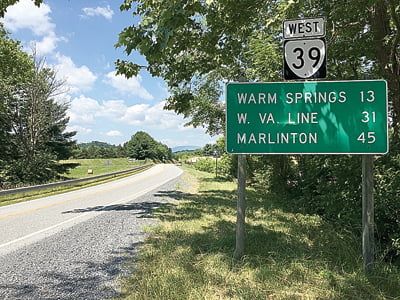
A view looking west along Rt. 39 at Rt. 42 in Millboro Springs, Virginia.
Cara Rose,
Executive Director
Pocahontas County
Convention and
Visitors Bureau
Every time I drive eastward over the Virginia line toward Staunton, a short trip by today’s standards, I am overcome with the beauty of this journey. The drive takes you through some of the most picturesque landscapes of our area and has very little development to scar the views, making it as scenic a drive as any. When I make this journey, I cannot help but wonder what the experience was like to journey to Marlinton across the scenic Route 39 in the early 1920s.
My grandmother did just that as a young lady when she moved from Churchville, Virginia, to Marlinton in the 1920s for her first job, which she held for 40 years.
Imagine that trip, coming across two mountains in what must have been an all-day affair.
I know few details of the story, only that she received her post high school education at Templeton Business School and earned a business certificate in shorthand in August 1923 at age 18. The business school had a job placement program in which the Bank of Marlinton participated. My grandmother was to be a career woman, something notable for the time. The Bank of Marlinton, founded in 1899, hired her, and her journey to Marlinton and her life story were both set in motion.
I imagine for a young lady about 20 years of age, the thought of moving to the mountains of West Virginia, 90 miles from her “metropolitan” home in Augusta County, was exciting and a little frightening.
She would have been escorted by a male relative, likely in a Model T Ford, which was a step up from the other option of traveling by horse. The road would have been dirt – muddy and narrow and more suited for horse and buggy than automobile. But, the drive must have been beautiful, and Marlinton was a thriving town. Pocahontas County was home to 15,000 people at the time. It had a new railroad, prosperous timbering operations and growing tanneries offered employment and brought people from all over to Marlinton and the county.
My grandmother lived in a boarding house for single women, and, somewhere along the way, she met my grandfather, a young man who worked at the tannery.
They married in 1924. My grandmother kept a diary in the early days of marriage, recording company that visited, daily routines, happenings in town and some quite entertaining stories.
The young married couple journeyed to Staunton at least once a month for decades, so my grandmother could remain close with her family.
My grandfather would say the drive to Staunton and back to Marlinton was treacherous at times. He recounted stories of being rescued when they slid into a ditch or had a flat tire or worse, sliding over the hill in the automobile. But they made the weekend journey to Staunton and back many, many times through the years. As roads were improved and paved and concrete bridges were built in the 1950s, the drive became more pleasant and tolerable.
We know the journey to Marlinton from Virginia is easier today than in the early 1900s, but I imagine it was just as scenic then as it is now. The landscape today is still unspoiled in so many ways – magnificent views, the majesty of a sunrise or sunset, the rolling hills dotted with cattle and sheep.
A trip on scenic Route 39 through Mountain Grove, Warm Springs, Buffalo Gap and Staunton is no longer an “all day affair,” but, still, it shouldn’t be rushed.



